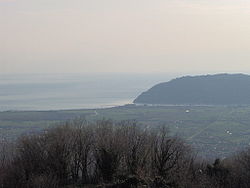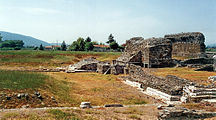Luni, Italy
This article needs additional citations for verification. (October 2010) |
It has been suggested that this article be merged with Luna (Etruria). (Discuss) Proposed since May 2014. |
Luni | |
|---|---|
 The plain of Luni and the village | |
 | |
| Country | Italy |
| Region | |
| Province | La Spezia (SP) |
| Comune | Ortonovo |
| Elevation | 20 m (70 ft) |
| Population (2001) | |
• Total | 1,000 |
| Demonym | Lunensi |
| Time zone | UTC+1 (CET) |
| • Summer (DST) | UTC+2 (CEST) |
| Postal code | 19034 |
| Dialing code | (+39) 0187 |
Luni is a small town under the comune (municipality) of Ortonovo, province of La Spezia, in the easternmost end of the Liguria region of northern Italy. It gives its name to Lunigiana, a region spanning eastern Liguria and northern Tuscany (province of Massa-Carrara). Points of interest include remains of the elliptical Roman amphitheatre (1st century AD) and the Archaeological Museum.
Geography
Located in a plain near the Tyrrhenian Sea and close to the borders with Tuscany, Luni is crossed by the river Magra and lies between Sarzana (7 km in north) and Carrara (5 km in south). It is 4 km far from Ortonovo, 15 from Massa and 30 from La Spezia. The village is served by the National Highway 1 "Aurelia", crossed at Luni Mare by the A12 motorway and counts a railway station on the Pisa-Genoa line.
History
Early history
Founded by the Romans in 177 BC with the name Luna,[1] at the mouth of the Magra,[2] it was a military stronghold for the campaigns against the Ligures: there is an inscription in the Archaeological Museum from the base of a triumphal column erected in the second consulate of C. Claudius Marcellus to commemorate the repression of the last rebellion of the Ligures. In 109 BC it was connected to Rome by the Via Aemilia Scauri, rebuilt in the 2nd century AD as the Via Aurelia. It flourished when exploitation of white marble quarries in the nearby Alpi Apuane began in the 1st century BC and soon owned by the imperial family. Pliny the Elder considered the big wheels of cheese from Luna the best in Etruria.
Late antiquity
In the 5th century, it was still notable, as it was chosen as the seat of a bishopric. Captured by the Goths in the following century, it was reconquered by the Byzantines in 552, who however lost it to the Lombards in 642. The latter damaged the city's economy, favouring the trades routes that passed through the nearby port of Lucca to the south. Luni had been reduced to a small village by the time of the Lombard king Liutprand. Later, it was a countship and see under Charlemagne, exactly on the border between the Kingdom of Italy and the Papal States.
The Middle Ages
It was repeatedly sacked by sea pirates, Saracens in 849 and Vikings in 860. In the mid-10th century it experienced the last period of splendour under count Oberto I, who was lord of the whole Ligurian Mark, and momentarily repulsed the pirate threat. However, in the 990s the situation worsened again, and the episcopal see was moved, first to Carrara then, definitively, to Sarzana in 1207. In 1015 Luna was conquered by the Andalusian emir of Denia, Mujāhid with his Sardinian ships: when Pisa and Genoa beat back his forces, Luni was left destroyed. The spreading of malaria in the area and the silting up of the port contributed to the steep decline of Luni. In 1058 the whole population moved to Sarzana, while other refugees founded Ortonovo and Nicola. The title of bishop and count of Luni remained in use for various centuries, but Petrarch noted Luni as "once famous and powerful and now only a naked and useless name".
It was only in 1442 that the highly visible remains were identified with Luni and the Gulf of La Spezia recognized as its harbour.[3] The depredation of the Roman ruins of Luni aroused the concern of the local Cardinal Filippo Calandrini, who urged the Humanist pope Pius II to issue a brief (7 April 1461) forbidding any further dilapidations. It was of little practical use: when the Palazzo del Commune of Sarzana was constructed in 1471 dressed stone from Luni supplied a considerable part of the building material.[4] In 1510 the city council of Sarzana made a gift to the French governor at Genoa of a marble triton found at Luni.[5]
Archaeological excavations
Luni was excavated in the 1970s and many of the treasures brought to light are now housed in the adjacent museum. Archeological evidence suggests that the Roman forum had been abandoned as a public space by the end of the sixth century, its buildings fell to ruin or were demolished and decorative marbles removed. Remains of small wooden houses were found in the space previously occupied by the forum.[6]
Gallery
-
The amphitheatre of Luna
-
The temple of Luna
-
Male portrait. Luni marble, Roman artwork of the period of the Second Triumvirate (43 BC)
Notes and references
- ^ Inscriptions at Luna attest to the cult of the moon goddess Luna.
- ^ The modern coastline of the Portus Lunae noted by Strabo is now two km distant.
- ^ Giacomo Bracelli, Descriptio orae ligusticae, noted by Roberto Weiss, The Renaissance Discovery of Classical Antiquity 1969:111.
- ^ Roberto Weiss, The Renaissance Discovery of Classical Antiquity (Oxford: Blackwell) 1969:112.
- ^ Weiss 1969:114.
- ^ Ward-Perkins, B. (1997) "Continuitists, catastrophists, and the towns of post-Roman Northern Italy", Papers of the British School at Rome, Vol. 65, pp. 157-176.



